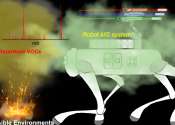China building more wind, solar capacity than rest of world combined: report
China is building almost twice as much wind and solar energy capacity as every other country combined, research published Thursday showed.
Jul 11, 2024
0
10
Energy & Green Tech

China is building almost twice as much wind and solar energy capacity as every other country combined, research published Thursday showed.
Jul 11, 2024
0
10
Engineering

Scientists say they have found a way to cool buildings that will reduce dependence on energy-hungry air conditioners.
Jul 9, 2024
0
23
Energy & Green Tech

Painting roofs white or covering them with a reflective coating would be more effective at cooling cities like London than vegetation-covered "green roofs," street-level vegetation or solar panels, finds a new study led by ...
Jul 4, 2024
1
152
Automotive

When the idea of electric air taxis emerged, Los Angeles was vying to be one of the first cities that would utilize the technology to help people avoid its infamous bumper-to-bumper traffic. Some city transportation officials ...
Jun 27, 2024
0
13
Business

Amazon is shifting from the plastic air pillows used for packaging in North America to recycled paper because it's more environmentally sound, and it says paper just works better.
Jun 20, 2024
0
14
Energy & Green Tech

The pressure is on for California to meet its clean-vehicle goals. In less than two years, 35% of vehicles sold must have zero tailpipe emissions. And by 2035, all light-duty vehicles sold must be zero-emissions.
Jun 14, 2024
0
30
Hi Tech & Innovation

As a Delta Air Lines jet began roaring down a runway, an air traffic controller at New York's John F. Kennedy International Airport suddenly blurted out an expletive, then ordered the pilots to stop their takeoff roll.
Jun 13, 2024
0
1
Robotics

Nightmare material or truly man's best friend? A team of researchers equipped a dog-like quadruped robot with a mechanized arm that takes air samples from potentially treacherous situations, such as an abandoned building ...
Jun 10, 2024
0
64
Energy & Green Tech

Researchers have developed a low-cost, energy-efficient method for making materials that can capture carbon dioxide directly from the air.
Jun 5, 2024
0
123
Business

Airlines may not be replacing pilots with artificial intelligence anytime soon, but aviation industry experts say the new technology is already revolutionizing the way they do business.
Jun 3, 2024
0
1
The Earth's atmosphere is a layer of gases surrounding the planet Earth that is retained by the Earth's gravity. It has a mass of about five quadrillion metric tons. Dry air contains roughly (by volume) 78.08% nitrogen, 20.95% oxygen, 0.93% argon, 0.038% carbon dioxide, and trace amounts of other gases. Air also contains a variable amount of water vapor, on average around 1%. The atmosphere protects life on Earth by absorbing ultraviolet solar radiation, warming the surface through heat retention (greenhouse effect), and reducing temperature extremes between day and night.
There is no definite boundary between the atmosphere and outer space. It slowly becomes thinner and fades into space. An altitude of 120 km (75 mi) marks the boundary where atmospheric effects become noticeable during atmospheric reentry. The Kármán line, at 100 km (62 mi), is also frequently regarded as the boundary between atmosphere and outer space. Three quarters of the atmosphere's mass is within 11 km (6.8 mi; 36,000 ft) of the surface.
This text uses material from Wikipedia, licensed under CC BY-SA